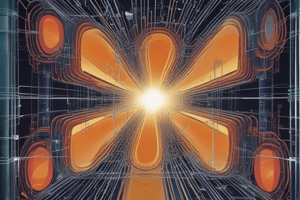Podcast
Questions and Answers
Which component in a photomultiplier tube converts light photons into low-energy electrons?
Which component in a photomultiplier tube converts light photons into low-energy electrons?
- Electron multiplier
- Photocathode (correct)
- Glass envelope
- Anode
Photodiodes are more mechanically stable than photomultiplier tubes.
Photodiodes are more mechanically stable than photomultiplier tubes.
True (A)
What is the typical range of electrons produced from a scintillation pulse in a photomultiplier tube?
What is the typical range of electrons produced from a scintillation pulse in a photomultiplier tube?
10^7 to 10^10
The outer envelope of a photomultiplier tube primarily serves as a __________ boundary.
The outer envelope of a photomultiplier tube primarily serves as a __________ boundary.
What is the primary application where photomultiplier tubes are preferred over photodiodes?
What is the primary application where photomultiplier tubes are preferred over photodiodes?
Match the following components of a photomultiplier tube with their functions:
Match the following components of a photomultiplier tube with their functions:
The response time of photodiodes is faster than that of photomultiplier tubes.
The response time of photodiodes is faster than that of photomultiplier tubes.
What structure in a PMT serves as an ideal amplifier to increase the number of photoelectrons?
What structure in a PMT serves as an ideal amplifier to increase the number of photoelectrons?
What is the first step in the photoemission process?
What is the first step in the photoemission process?
The quantum efficiency of an ideal photocathode is 50%.
The quantum efficiency of an ideal photocathode is 50%.
What is the typical range of quantum energy for blue light emitted by scintillators?
What is the typical range of quantum energy for blue light emitted by scintillators?
The process in which more than one electron is emitted from the surface after an incident electron strikes the dynode is called ______.
The process in which more than one electron is emitted from the surface after an incident electron strikes the dynode is called ______.
Match the following terms with their definitions:
Match the following terms with their definitions:
Which factor significantly affects the quantum efficiency of a photocathode?
Which factor significantly affects the quantum efficiency of a photocathode?
The minimum energy needed for an electron to escape is always below 1 eV.
The minimum energy needed for an electron to escape is always below 1 eV.
What is the typical time width produced by PM tubes after being illuminated by a short-duration light pulse?
What is the typical time width produced by PM tubes after being illuminated by a short-duration light pulse?
Study Notes
Introduction to Photomultiplier Tubes and Photodiodes
- Scintillators produce photons detectable by photomultiplier tubes (PMTs) and photodiodes (PDs).
- PMTs have delicate structures prone to damage, while PDs are more mechanically stable.
- PMTs have faster response times than PDs, making them preferable for timing applications.
- Typical PMT structure includes an outer glass envelope that maintains vacuum conditions essential for low-energy electron acceleration.
Structure of a Photomultiplier Tube
- The tube contains a photocathode, which converts incident photons into low-energy electrons, and an electron multiplier for amplification.
- The number of photoelectrons generated from scintillation pulses is often too low for direct signal detection.
- PMT's electron multiplier increases the number of electrons to approximately 10⁷ to 10¹⁰ for signal clarity.
- Output from the anode is proportional to the number of original photoelectrons, retaining timing information from the light pulse.
Photocathode: The Photoemission Process
- The photoemission involves three main stages:
- Absorption of an incident photon, transferring energy to an electron.
- Migration of the electron to the photocathode surface.
- Escape of the electron from the material to vacuum.
- The energy transferred from photon to electron is defined by quantum energy, approximately 3 eV for blue light.
- Some energy loss occurs during electron migration, impacting electron escape capability.
- Surface barrier (work function) should be minimized to enhance electron escape; typical values for metals are 3-4 eV, but suitable semiconductors can have lower barriers.
Quantum Efficiency and Spectral Response
- Photocathode sensitivity is commonly expressed in terms of photocurrent to light flux (amperes per lumen).
- Quantum efficiency (QE) is a critical measure, indicating the percentage of incident photons resulting in emitted electrons.
- Ideal photocathodes exhibit 100% QE, while typical values range from 20-30%.
- QE is highly dependent on the wavelength of incident light, making wavelength compatibility significant when selecting photocathodes.
Electron Multiplication: Secondary Electron Emission
- Photocathode-emitted electrons collide with dynodes, causing secondary electron emission.
- The impact energy of the initial electron leads to the release of multiple secondary electrons from the dynode surface.
- Kinetic energy of electrons from the photocathode is around 1 eV or less, but sufficient to initiate the multiplication process at the first dynode.
Studying That Suits You
Use AI to generate personalized quizzes and flashcards to suit your learning preferences.
Description
Explore the fundamental concepts of photomultiplier tubes and photodiodes in this quiz from Chapter 9. Learn about their mechanisms, advantages, and applications in detecting photons produced by scintillators. This chapter emphasizes the differences in mechanical stability and response times between these two crucial devices.




